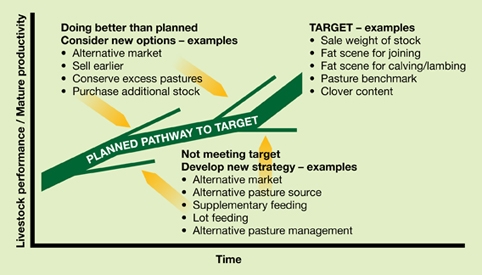Subscribe to MLA's e-newsletters
Stay informed with the latest red meat and livestock industry news, events, research and marketing.
Livestock breeding and growth
As the intensity of a production system increases, or market specifications tighten, matching pasture supply and quality to livestock needs with more precision makes management decisions more sensitive to pasture deficits and surpluses.
Always consider the costs associated with achieving the target growth pathways, together with returns from expected outcomes (see diagram below).

Nutrition has the biggest impact on breeding and growth within the lifetime of a productive animal. However, choice of animal genetics also impacts on the success of pathways through setting the production and market specific potential of the animals.
Nutrient requirements of an animal are a function of its weight, liveweight gain, sex, physiological state (pregnancy, lactation) and age. Nutrient requirements are also affected by the quality of feed eaten and time spent grazing, climate (particularly too cold or too hot), disease state and degree of social coherence with its colleagues.
Different genetic potential affects nutrient requirements through variation in weight for age, liveweight gain and reproductive capacity. Small effects due to genetic differences in muscling, fatness and fat distribution (marbling) are not taken into account when determining nutrient requirements.
Use a feeding standard based on animal requirements for metabolisable energy (ME) to convert animal nutrient requirements into the amount and quality of feed required is ME is defined as the energy available to an animal after losses due to digestion (faeces, urine, methane).
While methane plays a role in ruminant digestion, it represents a waste in energy and is the most potent greenhouse gas (GHG). Livestock emissions account for about 10% of Australia’s total greenhouse gas (GHG) emissions and about two thirds of the total emissions from agriculture.
The challenge is to reduce methane emissions while increasing productivity and profitability. If the energy used to produce methane can be redirected, animal growth can increase.
Best management practices for production efficiency offer the most practical short-term solution. These practices include improving feed quality and utilisation, turning off stock earlier, culling unproductive animals and improving reproduction rates.
Pasture quality - why ME matters
The ME content of pasture is a good measure of the nutritional value of the pasture in energy terms. The ME per kg of feed dry matter (units are MJ ME/kg DM) is the standard used in Australia. This is termed the ‘energy density’ of a feed and is the main driver of livestock growth per head and (managed appropriately) per hectare.
Energy density of a feed is the major limitation to livestock response. Provide additional important nutrients such as protein and minerals when energy requirements from pastures are achieved. When pastures are of low energy, protein may also be limiting.
Use the relationship between pasture quality and quantity and livestock performance to guide management decisions.


